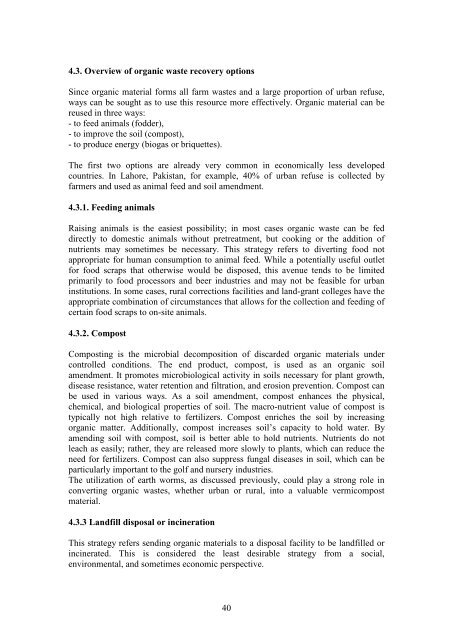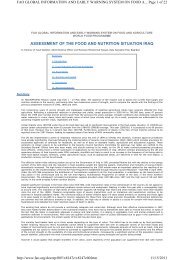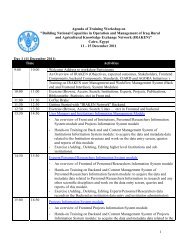Vermiculture in Egypt: - FAO - Regional Office for the Near East and
Vermiculture in Egypt: - FAO - Regional Office for the Near East and
Vermiculture in Egypt: - FAO - Regional Office for the Near East and
You also want an ePaper? Increase the reach of your titles
YUMPU automatically turns print PDFs into web optimized ePapers that Google loves.
4.3. Overview of organic waste recovery options<br />
S<strong>in</strong>ce organic material <strong>for</strong>ms all farm wastes <strong>and</strong> a large proportion of urban refuse,<br />
ways can be sought as to use this resource more effectively. Organic material can be<br />
reused <strong>in</strong> three ways:<br />
- to feed animals (fodder),<br />
- to improve <strong>the</strong> soil (compost),<br />
- to produce energy (biogas or briquettes).<br />
The first two options are already very common <strong>in</strong> economically less developed<br />
countries. In Lahore, Pakistan, <strong>for</strong> example, 40% of urban refuse is collected by<br />
farmers <strong>and</strong> used as animal feed <strong>and</strong> soil amendment.<br />
4.3.1. Feed<strong>in</strong>g animals<br />
Rais<strong>in</strong>g animals is <strong>the</strong> easiest possibility; <strong>in</strong> most cases organic waste can be fed<br />
directly to domestic animals without pretreatment, but cook<strong>in</strong>g or <strong>the</strong> addition of<br />
nutrients may sometimes be necessary. This strategy refers to divert<strong>in</strong>g food not<br />
appropriate <strong>for</strong> human consumption to animal feed. While a potentially useful outlet<br />
<strong>for</strong> food scraps that o<strong>the</strong>rwise would be disposed, this avenue tends to be limited<br />
primarily to food processors <strong>and</strong> beer <strong>in</strong>dustries <strong>and</strong> may not be feasible <strong>for</strong> urban<br />
<strong>in</strong>stitutions. In some cases, rural corrections facilities <strong>and</strong> l<strong>and</strong>-grant colleges have <strong>the</strong><br />
appropriate comb<strong>in</strong>ation of circumstances that allows <strong>for</strong> <strong>the</strong> collection <strong>and</strong> feed<strong>in</strong>g of<br />
certa<strong>in</strong> food scraps to on-site animals.<br />
4.3.2. Compost<br />
Compost<strong>in</strong>g is <strong>the</strong> microbial decomposition of discarded organic materials under<br />
controlled conditions. The end product, compost, is used as an organic soil<br />
amendment. It promotes microbiological activity <strong>in</strong> soils necessary <strong>for</strong> plant growth,<br />
disease resistance, water retention <strong>and</strong> filtration, <strong>and</strong> erosion prevention. Compost can<br />
be used <strong>in</strong> various ways. As a soil amendment, compost enhances <strong>the</strong> physical,<br />
chemical, <strong>and</strong> biological properties of soil. The macro-nutrient value of compost is<br />
typically not high relative to fertilizers. Compost enriches <strong>the</strong> soil by <strong>in</strong>creas<strong>in</strong>g<br />
organic matter. Additionally, compost <strong>in</strong>creases soil‟s capacity to hold water. By<br />
amend<strong>in</strong>g soil with compost, soil is better able to hold nutrients. Nutrients do not<br />
leach as easily; ra<strong>the</strong>r, <strong>the</strong>y are released more slowly to plants, which can reduce <strong>the</strong><br />
need <strong>for</strong> fertilizers. Compost can also suppress fungal diseases <strong>in</strong> soil, which can be<br />
particularly important to <strong>the</strong> golf <strong>and</strong> nursery <strong>in</strong>dustries.<br />
The utilization of earth worms, as discussed previously, could play a strong role <strong>in</strong><br />
convert<strong>in</strong>g organic wastes, whe<strong>the</strong>r urban or rural, <strong>in</strong>to a valuable vermicompost<br />
material.<br />
4.3.3 L<strong>and</strong>fill disposal or <strong>in</strong>c<strong>in</strong>eration<br />
This strategy refers send<strong>in</strong>g organic materials to a disposal facility to be l<strong>and</strong>filled or<br />
<strong>in</strong>c<strong>in</strong>erated. This is considered <strong>the</strong> least desirable strategy from a social,<br />
environmental, <strong>and</strong> sometimes economic perspective.<br />
40





